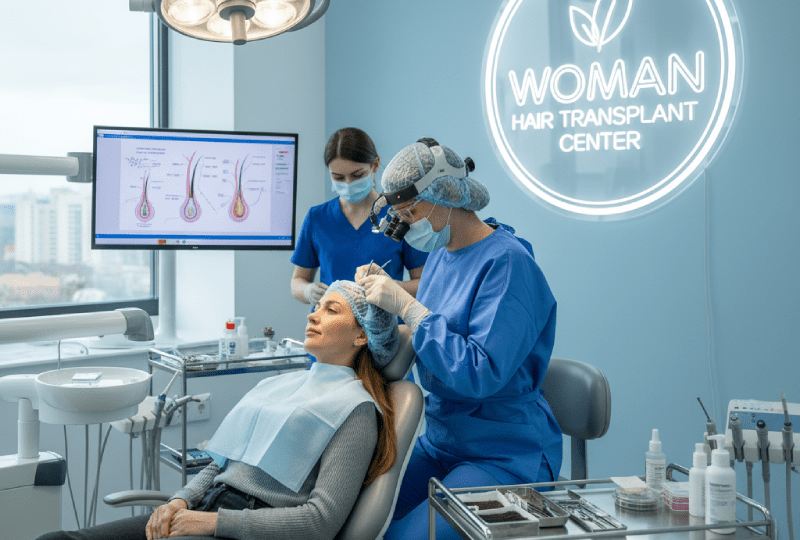Introduction: Is Women’s Hair Loss a Taboo?
For women, hair is one of the most important symbols of beauty and self-confidence. Therefore, hair loss is not just a physical problem; it is a sensitive issue that can create deep psychological and social effects. Although it is generally perceived as a problem unique to men, hair loss in women is quite common, and many women feel they have to hide this condition. This content aims to break this taboo and facilitate access to information by detailing the causes of hair loss in women, the existing solutions, and Turkey’s leading position in this field.
Causes of Female Pattern Hair Loss
Hair loss in women does not usually lead to complete baldness as it does in men; instead, it manifests as a general thinning and reduction in hair density. The underlying reasons for this condition are quite diverse, and often multiple factors combine to trigger hair loss. A proper diagnosis and an effective treatment plan require a good understanding of these causes. In this section, we will examine the main factors that lead to hair loss in women in detail.
Genetic Factors and Androgenetic Alopecia
One of the most common causes of hair loss in women is a genetic predisposition. Androgenetic alopecia, commonly known as “female pattern baldness,” is a genetically inherited condition caused by hair follicles becoming sensitive to the dihydrotestosterone (DHT) hormone. While it appears as a receding hairline in men, in women, it usually presents as thinning hair on the top of the head and a more visible scalp. This condition is seen in approximately 50% of women experiencing hair loss and typically becomes noticeable after the age of 40 or 50.
Hormonal Changes: Pregnancy, Menopause, and Thyroid Problems
Hormonal fluctuations in the body have a significant impact on hair health. Conditions such as pregnancy, menopause, polycystic ovary syndrome (PCOS), and thyroid disorders can seriously affect the hair cycle. For example, increased estrogen levels during pregnancy can make hair fuller, while a sudden drop in hormones after childbirth can lead to intense hair shedding known as “telogen effluvium.” Decreased estrogen and progesterone levels during menopause can also cause hair thinning. An imbalance in thyroid hormones directly affects the development of hair follicles, leading to hair loss.
The Link Between Nutritional Deficiencies and Hair Loss
Hair health is a reflection of the body’s overall nutritional status. Poor and unbalanced nutrition is an important factor that triggers hair loss. Deficiencies in iron, zinc, biotin, vitamin B12, vitamin D, and protein can weaken hair follicles and lead to shedding. Iron deficiency anemia is one of the most common nutrition-related causes of hair loss in women. Correcting these deficiencies with a proper diet can significantly improve hair health.
Stress and Telogen Effluvium
Intense physical or emotional stress can disrupt the hair cycle and lead to a condition called telogen effluvium. In this situation, hairs prematurely move from the growth phase (anagen) to the resting phase (telogen) and begin to shed in large numbers within a few months. Events like surgeries, severe illnesses, emotional trauma, or sudden weight loss can trigger telogen effluvium. This type of hair loss is generally temporary, and hair returns to its normal cycle once the stress factor is eliminated.
Tight Hairstyles and Traction Alopecia
Hairstyles that constantly pull the hair tight, such as ponytails, buns, or braids, can cause permanent hair loss known as traction alopecia. The continuous tension applied to the hair follicles can eventually weaken and even permanently damage the roots. This condition typically becomes prominent along the hairline and in the temple areas. To prevent this type of hair loss, it is important to use looser hairstyles and avoid putting pressure on the hair roots.
Non-Surgical Solutions to Stop Hair Loss
There are many non-surgical treatment options available for hair loss. The most popular of these are PRP (Platelet-Rich Plasma) and mesotherapy applications. In PRP, plasma enriched with growth factors, obtained from the person’s own blood, is injected into the scalp. This procedure can help revitalize hair follicles and promote new hair growth. Mesotherapy involves injecting a mixture of vitamins, minerals, and amino acids into the scalp. Both methods can be effective in slowing down hair loss and improving the quality of existing hair, but they do not provide a permanent solution.
Hair Transplant: A Permanent Solution for Women
Hair transplantation stands out as the permanent and most effective solution for hair loss in women. In this surgical procedure, healthy hair follicles from the donor area (usually the back of the head), which are resistant to shedding, are harvested and transplanted to the thinned or bald areas. This procedure ensures that the hair achieves a denser, fuller, and more natural appearance. Hair transplantation in women requires a different kind of expertise, as the goal is to increase hair density by transplanting between existing hairs, rather than filling in completely bald areas as in men.
Why Is Turkey a Hair Transplant Hub for Women?
Turkey is a world leader in hair transplantation and has not earned this reputation by chance. The country has high standards in terms of both technological equipment and expert surgeons. At the same time, offering much more affordable costs compared to Western countries has made Turkey an attractive destination for international patients. The incentives and experience in health tourism have allowed clinics to develop and increase patient satisfaction day by day. As a result, women can achieve the hair of their dreams with high-quality service without straining their budget.
FUE Technique: The Most Preferred Method for Women
The Follicular Unit Extraction (FUE) technique is the most widely used and reliable method for hair transplantation in women. In this method, hair follicles from the donor area are extracted one by one using special-tipped micromotors or manual punch tools. These follicles are then placed into the recipient area after a channel opening procedure. The FUE technique is preferred by both men and women because it is minimally invasive, has a fast recovery process, and provides natural results. In women, it can often be applied with the unshaven FUE method, which is a great advantage for patients with aesthetic concerns.

DHI Technique (Direct Hair Implantation) and Its Advantages
The Direct Hair Implantation (DHI) technique is a variation of the FUE method and is an ideal option, especially for women. In the DHI technique, hair follicles are harvested using a special tool called a Choi Pen and are directly implanted into the recipient area with the same tool, without a separate channel opening procedure. This minimizes the time the follicles are exposed to the air, ensuring a healthier transfer of hair follicles. The biggest advantage of the DHI technique is that it allows for transplantation between existing hairs and thus offers the possibility of unshaven hair transplantation.
Women’s Hair Transplant Process: A Step-by-Step Guide
The hair transplant process is a journey that lasts for months, starting from the initial consultation.
- Consultation: The first step is to meet with an experienced hair transplant specialist. In this meeting, the cause of your hair loss, the condition of your donor area, and your expectations are evaluated.
- Operation Day: The procedure is generally performed under local anesthesia and takes a few hours. Follicles are harvested from the donor area and transplanted to the recipient area.
- First Day After Operation: On the first day after the operation, the hair is washed and the bandages are removed.
- Recovery Process: In the first few weeks, crusting and redness are seen in the transplanted area.
- Shock Loss: The transplanted hair temporarily sheds within a few weeks. This is a normal process.
- New Hair Growth: New hairs begin to grow after approximately 3-4 months.
- Final Result: The full results of the hair transplant appear within 12 to 18 months.
Designing the Hairline and a Natural Look
One of the most critical stages of a hair transplant in women is designing a natural-looking hairline. An improperly designed hairline can make the procedure look artificial. An experienced surgeon determines the most suitable and natural-looking hairline by considering the patient’s face shape, age, hair structure, and head anatomy. The angle and direction of the hair follicle implantation are also vital for a natural look. At this stage, the hair transplant specialist’s artistic ability and experience make a big difference.
Donor Area: Where Are Follicles Taken From?
The donor area for hair transplantation in women may be more limited compared to men. Follicles resistant to shedding, usually in the back of the head, are used. However, in some women, the hair on the back of the head may also be weak. In this case, hair from behind the ears or body hair (such as from the arms or legs) can also be used. For women who do not have a sufficient donor area, a hair transplant may not be a suitable option, so this issue should be thoroughly evaluated during the consultation.
Unshaven Hair Transplant (Unshaven FUE): A Special Solution for Women
For women who care about their appearance, one of the biggest concerns about hair transplant surgery is having their hair cut short or completely shaved. The Unshaven Hair Transplant (Unshaven FUE) technique offers a perfect solution to this problem. In this method, the hair in the donor area is not completely shaved; only a small area from which the follicles will be taken is trimmed and camouflaged with the remaining hair. Since the recipient area is also not fully shaved, there is no need to withdraw from social life during the post-operative period, and the procedure is not noticeable. This technique is extremely popular among women and is successfully applied in many clinics in Turkey.
Post-Operative Care and Recovery Process
The success of a hair transplant largely depends on post-operative care. The first 10 days after the procedure are the most critical period. During this time, the patient should protect the transplanted area, use the special lotions and shampoos recommended by the doctor, and avoid physical activity. The first wash after the operation is usually performed by the clinic. Mild swelling, redness, and crusting in the transplanted area are normal during the recovery period. Strictly following the doctor’s instructions minimizes the risk of infection and speeds up recovery.
Hair Transplant Prices in Turkey: What Do Packages Include?
Hair transplant prices in Turkey vary depending on the clinic and the services offered. Prices are usually presented as a “package,” and these packages generally include the operation as well as accommodation, airport transfers, necessary medications, and post-operative care products. This allows patients to receive an all-inclusive service without having to plan the entire process themselves. The details of the package content may differ from clinic to clinic, so it is important to ensure everything is clearly discussed.
Why Are Prices More Affordable Than in Other Countries?
There are several key reasons why hair transplant costs in Turkey are more affordable than in other countries. First, the cost of living and labor wages are lower compared to Western countries. Second, Turkey has reached a massive volume in health tourism, which allows clinics to benefit from economies of scale and offer more services at a lower cost. Finally, the government’s policies supporting health tourism also ensure that prices in this field remain competitive. However, it is important to remember that an affordable price does not mean a compromise on quality; many clinics in Turkey use the latest technology and expert staff.
Choosing a Clinic: How to Find a Reliable Place?
Choosing the right clinic before undergoing a hair transplant operation is the most important step for a successful outcome.
- Expertise and Experience: The experience and references of the surgeon who will perform the operation should be researched.
- Technology and Equipment: It should be checked whether the clinic has up-to-date technology (like FUE, DHI).
- Patient Reviews: Platforms where previous patients share their experiences (social media, forums) should be examined.
- Certificates and Documents: It should be verified whether the clinic is approved by the Ministry of Health and has the necessary international certifications.
- Price Transparency: It should be clearly learned what is included in the price and whether there are any additional fees.
Pre-Operative Preparation and Things to Consider
There are some important points to consider before a hair transplant operation. It is necessary to stop using alcohol and cigarettes at least one week before the operation and to stop or discontinue blood-thinning medications (such as aspirin) under a doctor’s supervision. On the day of the operation, comfortable clothes should be preferred and breakfast should be eaten. All these precautions ensure that the operation goes more safely and comfortably.
Possible Side Effects and Complications After Hair Transplant
As with any surgical procedure, hair transplantation has some possible side effects and rare complications. These can include mild swelling, bruising, itching, and pain. These side effects usually subside on their own within a few days and can be managed with painkillers. More serious complications such as infection, bleeding, or scarring are quite rare and can usually be minimized by choosing the right clinic and specialist.
Patient Reviews and Experiences: Real Stories
For a woman considering a hair transplant, one of the most valuable sources of information is the reviews and experiences of people who have previously undergone the operation. Real stories shared on social media, blogs, or forums help potential patients see both the positive and negative aspects. These comments can provide important clues about the quality of a clinic and patient satisfaction.
Hair Transplant Results: When Do They Become Fully Visible?
A hair transplant is a process that requires patience. In the first few weeks, the transplanted hairs shed in a process called “shock loss.” This is normal and is a sign that the hair follicles are transitioning to the resting phase. New hairs begin to grow after approximately 3-4 months. The hairs may initially be thin and weak, but they thicken and strengthen over time. The final and most satisfying results are usually achieved 12 to 18 months after the operation.
Conclusion: A Hair Transplant for Women Can Be a Turning Point
For women, hair loss is a condition that seriously affects their self-confidence and quality of life. However, thanks to modern hair transplant techniques and especially Turkey’s expertise in this field, this problem can be permanently solved. A hair transplant is not just about regaining hair, but also about regaining one’s self-belief and joy in life. With proper research and the selection of the right clinic and specialist, this process can be a turning point in your life and open the doors to a happier, more confident future.



